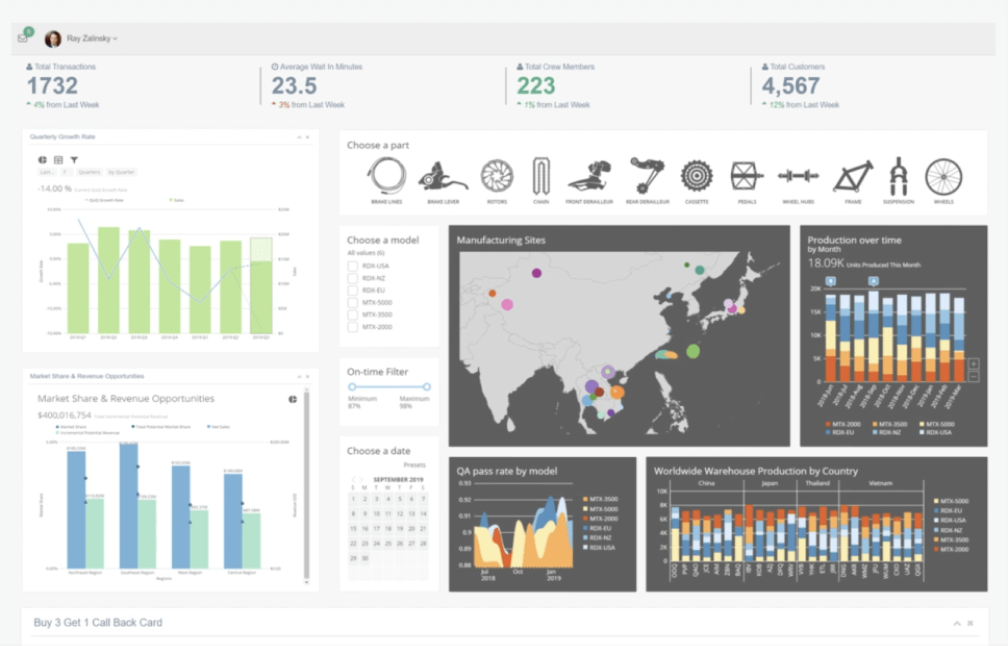How to create effective visualizations using business intelligence dashboards
Incorporating a business intelligence (BI) tool in an organization enables employees to extract, store, and visualize data with ease. Visualizing data through an interactive business intelligence dashboard provides users with the necessary means to gain meaningful insights from the data in real time.
If a user wants to know which region is generating the most sales, they can use a business intelligence dashboard to visualize the appropriate data and then filter by time period and region. Many other similar questions can be answered almost instantaneously thanks to BI.
Dashboards generally consist of multiple visualization cards that come together to tell a story and address pertinent business questions. BI dashboards give users the flexibility to explore the data in order to make prompt and informed decisions because these dashboards provide all the necessary information in one location. Many BI dashboard tools provide the ability to access visualizations through any type of device, which means users can interact with data and make decisions on the go.

What is data visualization?
Data visualization is simply the turning of raw data into a visual format. Unlike computers, humans are not very good at making sense of large amounts of raw data. In order to make the data useful to people who must understand the data in order to make informed decisions, BI tools display that data in a more comprehensible way. The type of visualization that you use to display the data depends on the structure of the data and the business questions that you want to address.
How to visualize data using business intelligence
Before it’s ready to be visualized, almost all the data must be collected, cleaned, and prepared. Business intelligence dashboard tools that are considered “full-stack” offer features that assist in the data preparation process. Some BI tools enable even non-technical users to easily perform data cleaning steps so that the associated visualizations are top notch.
These are generally the steps to follow to effectively create data visualizations:
- Identify the metrics you’ll want to visualize and the associated data sources. This will help you know where to draw the data from and what transformations will be needed.
- Gather the data from the appropriate repositories, such as a CRM, an on-premise SQL Server database, or Excel files. All this data can be stored centrally in a data warehouse as part of the BI software.
- After the data is brought into the BI tool, it’s time to transform it. Most data must be cleaned before it is visualized. This cleaning could involve changing data types, creating calculated fields, and manipulating text values using regular expressions (regex).
- Choose the visualization chart type based on the data and the business questions you want to answer.

Common data visualization types
Choosing the visualization type for your data is a critical step that is commonly overlooked. Each visual style is specifically matched to the type of phenomenon you want to display (composition, relationship, comparison, or distribution). Let’s take a closer look at the most common chart types used in business intelligence dashboard visualizations.
Bar chart
One of the simplest methods for comparing different data units is to use a bar chart. The bars can be stacked or arranged in clusters to show dispersion across market segments or product subcategories. The same is true for horizontal bar charts, which suit the placement of long data labels better on the bars.
Use a bar chart when comparing categories with numerical data. Put stacks in bars to separate each category into subcategories for a more thorough comparison.
Pie chart
A pie chart is another popular chart form that we see everywhere. Users can utilize this type of chart to show the distribution of some metric across different categories and how much of the whole each category contributes.
Use a pie chart when analyzing a metric’s composition as part of a whole.
Line graph
The value of a unit over time is represented by this type of visual using a vertical axis and horizontal axis. To show data from many dimensions, line graphs may be used in conjunction with bar charts.
Use a line graph when examining the change of a metric’s values over time.
Box plot
A box plot appears rather complex at first glance, but a closer look shows that a box plot shows the distribution of a variable’s values.
The minimum, the maximum, and the median, which is positioned between the first and third quartiles, are our primary components chart. A box displays the distribution of values together with their variance from the median.
Use a box plot when examining the distribution of values and their deviation from the median.
Scatter plot
Scatter plots are used to visualize the relationship between two numerical variables. The X and Y axes are the foundation of this type of representation. There are dots between them that serve as object identifiers. The attributes of a dot are indicated by its position on the graph.
Use a scatter plot when observing two numerical features of a data set to examine the relationship between them.
Radar chart
Essentially, this kind of chart is a line chart with radial lines. Multiple axes and variables combine to make a spiderweb-like shape.
Because there are so many dimensions, you can contrast units from different perspectives and visually display differences across dimensions.
Use a radar chart when comparing several items to one another across various dimensions.
Density map
Density maps take the geographic domain of the data and superimpose a visualization on the map. Dots placed on the map indicate the locations of each unit. The more dots there are in an area specifies a higher density of instances of an occurrence of a variable. A dot can represent a single entity or a collection of items in a given space.
Use a density map when illustrating the density of occurrences in a geographic area.
Funnel charts
These are excellent for illustrating stages throughout a process. Most of the time, to distinguish steps, funnels will use both geometric shapes and color-coding.
Use a funnel chart when showing the progression of a process with a decreasing range of values.
A catalog that describes each type of table, graph, chart, or map is available if you wish to go deep into data visualization types. Ensure that you fully comprehend the following points before selecting the type of visualization:
- Charts typically used in your organization’s industry
- Your intended audience
- The data types of the metrics you’ll display
- The phenomena you’ll display (relationship, distribution, etc.)
Tools and libraries for data visualization
The market for data visualization has a wide variety of products. When selecting a vendor, seek a scalable BI service that will meet your business’s size and analytical requirements. Even though the capabilities are quite comparable, the ecosystems that each vendor is providing may or may not provide all the necessary features.
Additionally, keep the cost in mind as you search for the right BI dashboard tool for your organization. Some tools are free, but the majority of tools require a payment due to the sophisticated analytical approaches, supporting infrastructure, and explicit features that free options don’t have.
Another aspect you’ll want to consider as you search for a BI dashboard tool is collaboration features. Dashboards are so much more valuable if you can share them with others across your organization, so everyone is on the same page as decisions are made. Many dashboard software tools give you the capability to share visualizations with others based on personalized data permissions.
Once you decide on the right BI dashboard tool for your business, you’ll be able to quickly draw insights from data by creating effective visualizations that will drive success.
Check out some related resources:

Power to Your People: The New Data Experience

Data-Driven Decisions Are Both Science and Art






